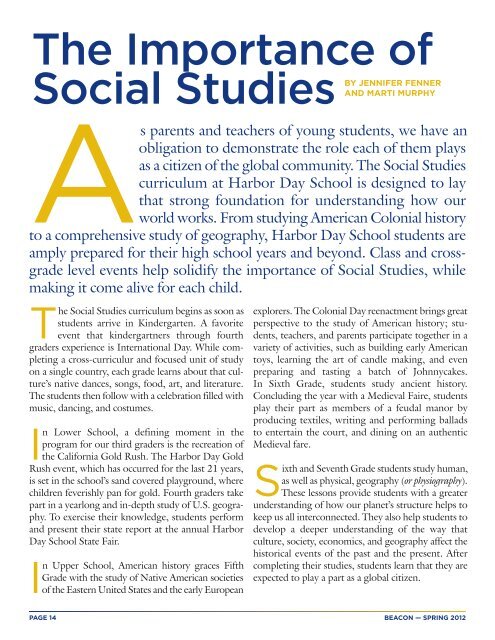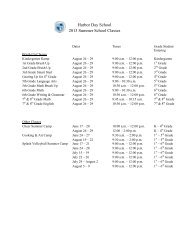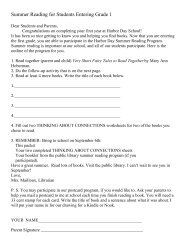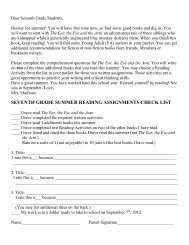MEMORIES THAT STICK - Harbor Day School
MEMORIES THAT STICK - Harbor Day School
MEMORIES THAT STICK - Harbor Day School
Create successful ePaper yourself
Turn your PDF publications into a flip-book with our unique Google optimized e-Paper software.
The Importance of<br />
Social Studies<br />
BY<br />
JENNIFER FENNER<br />
AND MARTI MURPHY<br />
As parents and teachers of young students, we have an<br />
obligation to demonstrate the role each of them plays<br />
as a citizen of the global community. The Social Studies<br />
curriculum at <strong>Harbor</strong> <strong>Day</strong> <strong>School</strong> is designed to lay<br />
that strong foundation for understanding how our<br />
world works. From studying American Colonial history<br />
to a comprehensive study of geography, <strong>Harbor</strong> <strong>Day</strong> <strong>School</strong> students are<br />
amply prepared for their high school years and beyond. Class and crossgrade<br />
level events help solidify the importance of Social Studies, while<br />
making it come alive for each child.<br />
The Social Studies curriculum begins as soon as<br />
students arrive in Kindergarten. A favorite<br />
event that kindergartners through fourth<br />
graders experience is International <strong>Day</strong>. While completing<br />
a cross-curriculur and focused unit of study<br />
on a single country, each grade learns about that culture’s<br />
native dances, songs, food, art, and literature.<br />
The students then follow with a celebration filled with<br />
music, dancing, and costumes.<br />
In Lower <strong>School</strong>, a defining moment in the<br />
program for our third graders is the recreation of<br />
the California Gold Rush. The <strong>Harbor</strong> <strong>Day</strong> Gold<br />
Rush event, which has occurred for the last 21 years,<br />
is set in the school’s sand covered playground, where<br />
children feverishly pan for gold. Fourth graders take<br />
part in a yearlong and in-depth study of U.S. geography.<br />
To exercise their knowledge, students perform<br />
and present their state report at the annual <strong>Harbor</strong><br />
<strong>Day</strong> <strong>School</strong> State Fair.<br />
In Upper <strong>School</strong>, American history graces Fifth<br />
Grade with the study of Native American societies<br />
of the Eastern United States and the early European<br />
explorers. The Colonial <strong>Day</strong> reenactment brings great<br />
perspective to the study of American history; students,<br />
teachers, and parents participate together in a<br />
variety of activities, such as building early American<br />
toys, learning the art of candle making, and even<br />
preparing and tasting a batch of Johnnycakes.<br />
In Sixth Grade, students study ancient history.<br />
Concluding the year with a Medieval Faire, students<br />
play their part as members of a feudal manor by<br />
producing textiles, writing and performing ballads<br />
to entertain the court, and dining on an authentic<br />
Medieval fare.<br />
Sixth and Seventh Grade students study human,<br />
as well as physical, geography (or physiography).<br />
These lessons provide students with a greater<br />
understanding of how our planet’s structure helps to<br />
keep us all interconnected. They also help students to<br />
develop a deeper understanding of the way that<br />
culture, society, economics, and geography affect the<br />
historical events of the past and the present. After<br />
completing their studies, students learn that they are<br />
expected to play a part as a global citizen.<br />
PAGE 14 BEACON — SPRING 2012





